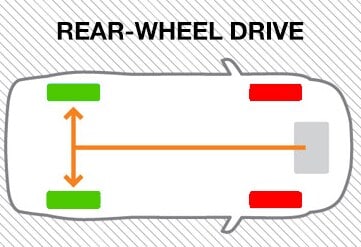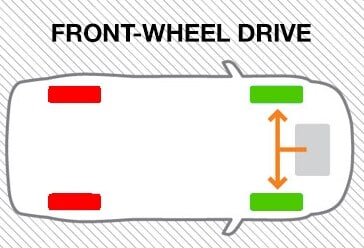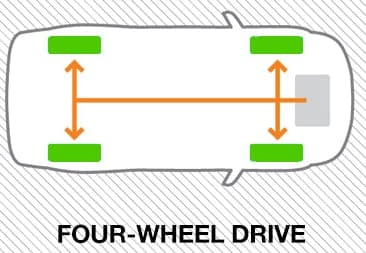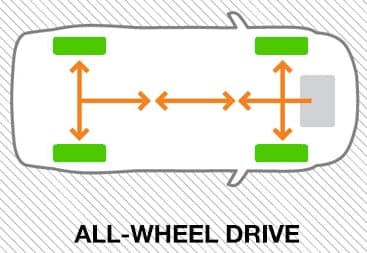Choosing the Right Wheel Drive System for You
Most drivers are familiar with the terms rear-wheel, front-wheel, four-wheel, and all-wheel drive, but few actually know their meaning. Each one represents a different system of operation, varying in how power is allocated to the wheels, which means their advantages differ depending on the situation. Thus, knowing how they work will help you choose the best wheel drive system for your everyday needs.
Understanding Differential and Weight Transfer
Before you can understand the different wheel drive systems available, you must first understand two elements that affect its functionality: differential and weight transfer.
In the automotive industry, differential refers to the system that regulates the variance in spin rate and traction of a set of wheels bound to the same axle. To put it into perspective, imagine making a turn. The wheels on the outside of the turn must travel a greater distance in comparison to the wheels on the inside and must therefore spin faster to make up the difference. In other words, the differential is responsible for modulating the power delivered to the wheels.
To be even more specific, there are two types of differentials. The basic variant is an "Open Differential" which sends equal power to the wheels. This is optimal for driving on a level surface but can cause wheels to spin when roads are rough or slippery because traction is distributed evenly and not to the wheel that needs it most. Many manufacturers now offer some form of a "Limited-Slip Differential" for this reason. As its name suggests, it adapts the traction sent to the wheels as well to reduce the likelihood of a slip. Naturally, the latter is preferred in regions that experience difficult road conditions such as ice.
Weight transfer is the process when weight shifts from the front to the back of the vehicle and vice versa. Weight shifts in the opposite direction of the vehicle's movement. In other words, weight shifts to the rear during acceleration and to the front during braking, compressing suspension and increasing grip.
Ultimately, the difference between wheel drive systems rest on their differential and weight transfer.
Choices for Wheel Drive Systems

Vehicles with Rear-Wheel Drive are propelled by the rear wheels because power is sent to the differential on the back axle. In turn, the front wheels are utilized for steering. The layout of how these components are housed creates a relatively balanced weight among all four wheels. This enables a vehicle to not only handle greater outputs of power but drive with increased precision. As an additional benefit, it is easy and affordable to manufacture and remains the system of choice for most trucks, multi-passenger vehicles, and performance cars as a result.
 Conversely, vehicles with Front-Wheel Drive are pulled with the front wheels. Drivetrain components like the engine and transmission are coupled with the differential as one unit at the front end, putting most of the weight forward. This frees up space, facilitating lighter weight models that are more fuel efficient on the road and spacious inside. With as much as 65 percent of the weight is positioned up front, this system is excellent in terms of traction but can cause wear and tear on the front wheels which do most of the labor.
Conversely, vehicles with Front-Wheel Drive are pulled with the front wheels. Drivetrain components like the engine and transmission are coupled with the differential as one unit at the front end, putting most of the weight forward. This frees up space, facilitating lighter weight models that are more fuel efficient on the road and spacious inside. With as much as 65 percent of the weight is positioned up front, this system is excellent in terms of traction but can cause wear and tear on the front wheels which do most of the labor.
 A vehicle with Four-Wheel Drive has the capacity to use two or all four wheels as the stimulus for forward motion because it wields what is known as a transfer case. This device allows drivers to engage with varied road conditions more effectively, which is why a 4x4 system (as it is sometimes called) is often found on trucks, sports utility vehicles, and off-roading models. Locking into four-wheel drive mode on low-traction surfaces can have a negative impact on the wheels and driveline components, so it is best reserved for the proper circumstance like mud or snow. Fortunately, automakers have developed a technology that monitors and switches between two-wheel and four-wheel drive automatically.
A vehicle with Four-Wheel Drive has the capacity to use two or all four wheels as the stimulus for forward motion because it wields what is known as a transfer case. This device allows drivers to engage with varied road conditions more effectively, which is why a 4x4 system (as it is sometimes called) is often found on trucks, sports utility vehicles, and off-roading models. Locking into four-wheel drive mode on low-traction surfaces can have a negative impact on the wheels and driveline components, so it is best reserved for the proper circumstance like mud or snow. Fortunately, automakers have developed a technology that monitors and switches between two-wheel and four-wheel drive automatically.

Finally, a vehicle with All-Wheel Drive offers the best overall traction because it uses all four of its wheels as impetus. Its configuration shares many similarities to a four-wheel drive system, but the transfer case is replaced by a limited slip differential that controls both front and rear axles. This flexibility is automatic, relieving the driver of the need to determine the best driving mode, and is largely the reason this system is popular with the average driver living in states with extreme seasonal changes. However, it is not the ideal choice for heavy-duty work.
Speak with a Herb Chambers Expert to Find the Right Drive System for You
With so many choices at your disposal, you may still find it difficult to choose the right drive system for you. In such a case, we recommend that you speak with an auto specialist at a Herb Chambers dealership and test drive options that are now available. In doing so, you will have a better understanding of each configuration and how they will affect your driving experience. Rest assured, our team will make sure that the model you take home will provide an exceptional ride at all times.
 View Inventory
View Inventory